What happens under Amtrak? Doe the line become entirely passenger by Amtrak buying it from the ATSF?After Amtrak, the Surf Line
You are using an out of date browser. It may not display this or other websites correctly.
You should upgrade or use an alternative browser.
You should upgrade or use an alternative browser.
Railroad thread
- Thread starter Duke Andrew of Dank
- Start date
Thought I'd take some more derivative ideas form @TheMann and @Lucas for this new set of photos:
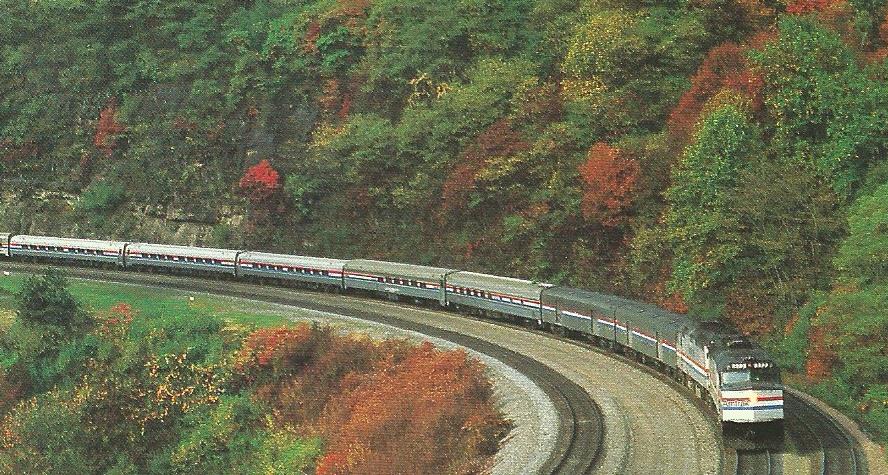
Amtrak's American President, so named because of President Reagan helping to scout a route when it debuted in 1983, is seen here on the PRR's Horseshoe Curve. On can tell this is from before 1985 because of the fact that the fourth rail has not been restored, and the fact that electrics are not featured. As one of the most prestigious of the Coast-Coast Amtrak services, it is natural that the train is as long as it is in this photo.

Amtrak Midwest's new Siemens Charger locomotives, #4602, is leading the Chicago Bypass regional service into Champaign, IL on the evening of June 12, 2017. This train runs over the New York Central's secondary lines from Peoria, IL to Danville, IL. At Danville, the train then runs over the Chessie's former Wabash to Toledo, OH via Lafayette and Ft. Wayne, IN. These engines can also be seen on many other Amtrak Midwest feeder lines.
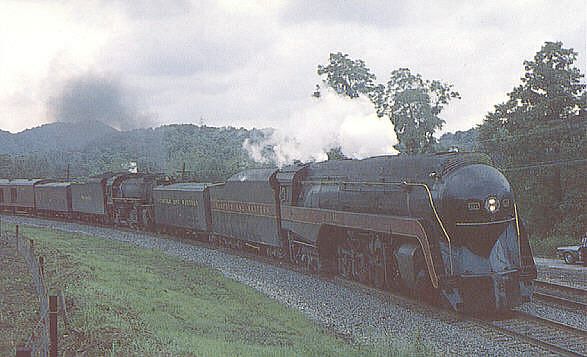
Norfolk & Western 611 and Nickel Plate 587 lead one of several Steamtown excursions operated in celebration of F. Nelson Blounts 70th birthday on May 21, 1998. Here we see the two engines on their way to Binghamton, NY over the Erie Lackawanna mainline.
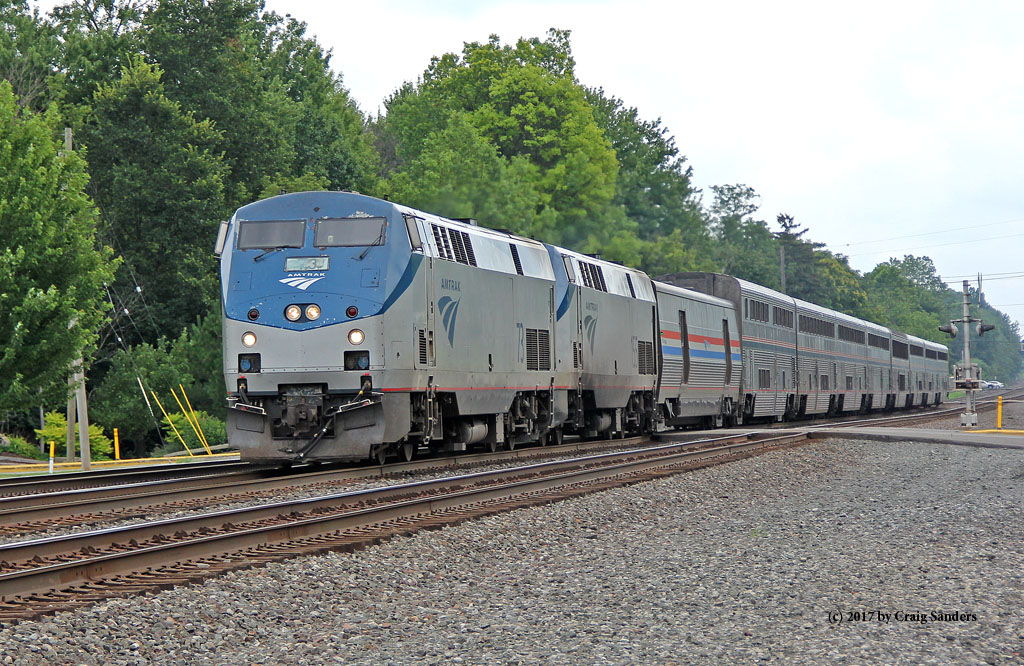
Amtrak's Pioneer makes its way along the Union Pacific's former Chicago NorthWestern mainline near Union, IL.

Amtrak's American President, so named because of President Reagan helping to scout a route when it debuted in 1983, is seen here on the PRR's Horseshoe Curve. On can tell this is from before 1985 because of the fact that the fourth rail has not been restored, and the fact that electrics are not featured. As one of the most prestigious of the Coast-Coast Amtrak services, it is natural that the train is as long as it is in this photo.

Amtrak Midwest's new Siemens Charger locomotives, #4602, is leading the Chicago Bypass regional service into Champaign, IL on the evening of June 12, 2017. This train runs over the New York Central's secondary lines from Peoria, IL to Danville, IL. At Danville, the train then runs over the Chessie's former Wabash to Toledo, OH via Lafayette and Ft. Wayne, IN. These engines can also be seen on many other Amtrak Midwest feeder lines.

Norfolk & Western 611 and Nickel Plate 587 lead one of several Steamtown excursions operated in celebration of F. Nelson Blounts 70th birthday on May 21, 1998. Here we see the two engines on their way to Binghamton, NY over the Erie Lackawanna mainline.

Amtrak's Pioneer makes its way along the Union Pacific's former Chicago NorthWestern mainline near Union, IL.
Regarding what @TheMann said about the Alameda Corridor, I've thought of the idea of the corridor AND the Surf Line actually being owned jointly by the SP and ATSF. Meanwhile, the Harbor Sub would be acquired by Pacific Electric like what TheMann proposed, but I could also maybe see it becoming a line shared with the Pacific Harbor Line.
@TheMann
Lately I've had second thoughts about the ATSF continuing their own passenger service.
As such, one idea I've considered is that Amtrak comes around a bit earlier and not as many freight roads surrender their services to them at first. This changes by the 1996 of my TL though, when the ATSF would run its last passenger train.
Lately I've had second thoughts about the ATSF continuing their own passenger service.
As such, one idea I've considered is that Amtrak comes around a bit earlier and not as many freight roads surrender their services to them at first. This changes by the 1996 of my TL though, when the ATSF would run its last passenger train.
AMTRAK TO REVEAL HERITAGE UNITS THIS YEAR
At a recent conference, Amtrak CEO David Gunn confirmed that the Amtrak Group will be ordering its next batch of EMD F59PHI locomotives painted in the liveries of various railroads that it took passenger rail over from those railroads include:
- Pennsylvania
- New York Central
- Delaware & Hudson
- Erie Lackawanna
- Baltimore & Ohio
- Missouri Pacific
- Santa Fe
- Milwaukee Road
- Rock Island
- Rio Grande
- Southern Pacific
- Union Pacific
- Great Northern
- Northern Pacific
- Louisville & Nashville
- Southern
- Chesapeake & Ohio/Pere Marquette
- Illinois Central
More details will arrive in the coming months.
- TRAINS Magaine; June 23, 1994
OOC: This is for if I don't go through with the ATSF keeping passenger service, in which case the ATSF unit will not be present.
At a recent conference, Amtrak CEO David Gunn confirmed that the Amtrak Group will be ordering its next batch of EMD F59PHI locomotives painted in the liveries of various railroads that it took passenger rail over from those railroads include:
- Pennsylvania
- New York Central
- Delaware & Hudson
- Erie Lackawanna
- Baltimore & Ohio
- Missouri Pacific
- Santa Fe
- Milwaukee Road
- Rock Island
- Rio Grande
- Southern Pacific
- Union Pacific
- Great Northern
- Northern Pacific
- Louisville & Nashville
- Southern
- Chesapeake & Ohio/Pere Marquette
- Illinois Central
More details will arrive in the coming months.
- TRAINS Magaine; June 23, 1994
OOC: This is for if I don't go through with the ATSF keeping passenger service, in which case the ATSF unit will not be present.
Should I move this all to this new thread of mine?
Lately, I've had an idea for the 1960s of my TL.
Long story short, what if the Reading supplemented the T-1s they used on the Reading Rambles were supplemented with a pair of G3 Pacifics? I could see #213 and @216 being preserved for such jobs. Whereas afterwards I'd preserve #213 at Reading and #216 at the IRM in Union.
Long story short, what if the Reading supplemented the T-1s they used on the Reading Rambles were supplemented with a pair of G3 Pacifics? I could see #213 and @216 being preserved for such jobs. Whereas afterwards I'd preserve #213 at Reading and #216 at the IRM in Union.
I was thinking about the Tribeca Station idea I worked on with @TheMann, and thought I'd detail some of the famous name trains that stopped there in my TL.

The Crusader, run jointly between the CNJ and Reading, ran from Tribeca to Jersey City behind an electric, then would be hauled by a streamlined Pacific the rest of the way to Philadelphia.

The B&O's National Limited, which ran from Tribeca Station to St. Louis, was often powered by one of the many P7 Class Pacifics that the B&O streamlined. One of them being #5301, which is seen taking on water on the point of the train at Vincennes, IN on June 13, 1944.

The Erie Limited, the Erie's primary passenger train to Chicago, took advantage of the fact its mainline eschewed most major cities, and made limited stops as a result. Here, we see a Pacific leading the train near Port Jervis, NJ.

The Crusader, run jointly between the CNJ and Reading, ran from Tribeca to Jersey City behind an electric, then would be hauled by a streamlined Pacific the rest of the way to Philadelphia.

The B&O's National Limited, which ran from Tribeca Station to St. Louis, was often powered by one of the many P7 Class Pacifics that the B&O streamlined. One of them being #5301, which is seen taking on water on the point of the train at Vincennes, IN on June 13, 1944.

The Erie Limited, the Erie's primary passenger train to Chicago, took advantage of the fact its mainline eschewed most major cities, and made limited stops as a result. Here, we see a Pacific leading the train near Port Jervis, NJ.
^ I could see the B&O going the electrification route for the entire Washington-New York route ITTL too, if they are going to go to the cost of building Tribeca Station and the tunnels to get to it from the New Jersey side, particularly since the Reading was already using electric power for part of the route by the 1930s. The B&O's Midwest trains would use electric power as far as Baltimore, then switch to steam (or diesel) power there, the latter more likely because the B&O was an early user of diesel power on its passenger trains.
Idea on that front: have Kálmán Kandó's work be recognized by George H. Emerson (B&O's motive power boss), have him live longer and come to the US as the situation deteriorates in Europe. Kando and the shop crews at Mount Clare develop a prototype electric based on Kondo's work and others which performs beautifully, and during the WPA days have the B&O apply for money to help pay for railroad electrification at 25 kV 50 Hz, and thus as the PRR goes electric (and builds the GG1s for it), Kondo, Westinghouse and the B&O create their own electric locomotive for the Royal Blue. The cost of electrification would be less than the tunnels or station (especially the former), and thus the B&O continues to slug it out with the PRR, while the Reading uses the 25 kV system for electrifying its passenger operations and many of its heavily-graded freight routes as well, likewise the CNJ goes electric for the Blue Comet.
After the war, the PRR and New Haven eventually recognize the superiority of the 25 kV system and as new trains come to the Northeast Corridor in the 1960s, the PRR rebuilds the electrification to the B&O standard. The states take over commuter operations way sooner than OTL, and the Long Island Railroad eventually builds a tunnel to Tribeca Station in the 1960s, as does the PATH system, which makes Tribeca its end point after its Manhattan terminus is demolished to make way for the World Trade Center in the late 1960s. One Amtrak takes over the long-distance passenger trains, Tribeca Station passes off its long-distance trains to Penn Station, but the Long Island Railroad and New Jersey Transit focus their own Manhattan trains on Penn Station, and the Shore Line East comes to fruition way ahead of OTL, resulting in the NEC fast trains all going to Penn Station, while Metro-North and Shore Line East go to Grand Central and Long Island Railroad and New Jersey Transit trains all go to Tribeca.
Idea on that front: have Kálmán Kandó's work be recognized by George H. Emerson (B&O's motive power boss), have him live longer and come to the US as the situation deteriorates in Europe. Kando and the shop crews at Mount Clare develop a prototype electric based on Kondo's work and others which performs beautifully, and during the WPA days have the B&O apply for money to help pay for railroad electrification at 25 kV 50 Hz, and thus as the PRR goes electric (and builds the GG1s for it), Kondo, Westinghouse and the B&O create their own electric locomotive for the Royal Blue. The cost of electrification would be less than the tunnels or station (especially the former), and thus the B&O continues to slug it out with the PRR, while the Reading uses the 25 kV system for electrifying its passenger operations and many of its heavily-graded freight routes as well, likewise the CNJ goes electric for the Blue Comet.
After the war, the PRR and New Haven eventually recognize the superiority of the 25 kV system and as new trains come to the Northeast Corridor in the 1960s, the PRR rebuilds the electrification to the B&O standard. The states take over commuter operations way sooner than OTL, and the Long Island Railroad eventually builds a tunnel to Tribeca Station in the 1960s, as does the PATH system, which makes Tribeca its end point after its Manhattan terminus is demolished to make way for the World Trade Center in the late 1960s. One Amtrak takes over the long-distance passenger trains, Tribeca Station passes off its long-distance trains to Penn Station, but the Long Island Railroad and New Jersey Transit focus their own Manhattan trains on Penn Station, and the Shore Line East comes to fruition way ahead of OTL, resulting in the NEC fast trains all going to Penn Station, while Metro-North and Shore Line East go to Grand Central and Long Island Railroad and New Jersey Transit trains all go to Tribeca.
@TheMann
That's actually a pretty good idea. Let's not also forget the Erie Limited, Phoebe Snow, Crusader, all being handled by said electrics into Jersey City.
I also had the idea that the RDG/CNJ could revitalize the Valley Queen as a streamliner to serve as a Harrisburg counterpart to the Crusader, as well as a route for people heading the Harrisburg that bypasses the congestion of Philadelphia.
The idea of Kandó coming over to the US also would fit well if this railroad TL idea were to share a universe with this DBWI.
That's actually a pretty good idea. Let's not also forget the Erie Limited, Phoebe Snow, Crusader, all being handled by said electrics into Jersey City.
I also had the idea that the RDG/CNJ could revitalize the Valley Queen as a streamliner to serve as a Harrisburg counterpart to the Crusader, as well as a route for people heading the Harrisburg that bypasses the congestion of Philadelphia.
The idea of Kandó coming over to the US also would fit well if this railroad TL idea were to share a universe with this DBWI.
Lately I've been thinking of ideas for who steam reigning on American rails could be extended for at least another few years.
Basically, it's my idea for a US v. British Empire Cold War as a consequence of an Allied Japan and Axis USSR. Except with the British having a near complete hegemony over the world's oil supplies, the US is forced to continue putting up with steam engines or starting to electrify various rail lines.
Of course, being that this Cold War is briefer, steam is completely gone by 1965. What helps accelerate steam's eventual, albeit delayed, decline even further is the discovery of oil in French West Africa.
Basically, it's my idea for a US v. British Empire Cold War as a consequence of an Allied Japan and Axis USSR. Except with the British having a near complete hegemony over the world's oil supplies, the US is forced to continue putting up with steam engines or starting to electrify various rail lines.
Of course, being that this Cold War is briefer, steam is completely gone by 1965. What helps accelerate steam's eventual, albeit delayed, decline even further is the discovery of oil in French West Africa.
Lately I've been thinking of ideas for who steam reigning on American rails could be extended for at least another few years.
Basically, it's my idea for a US v. British Empire Cold War as a consequence of an Allied Japan and Axis USSR. Except with the British having a near complete hegemony over the world's oil supplies, the US is forced to continue putting up with steam engines or starting to electrify various rail lines.
Of course, being that this Cold War is briefer, steam is completely gone by 1965. What helps accelerate steam's eventual, albeit delayed, decline even further is the discovery of oil in French West Africa.
The problems there are that in 1941 over eight out of ten oil wells ever drilled had been in the United States, Venezuela, Iran and Argentina's oil supplies were well known to the United States and in that scenario Operation Paperclip could easily bring out the scientists responsible for the creation of the Fischer-Tropsch process and begin making large quantities of synthetic petroleum.
I see...The problems there are that in 1941 over eight out of ten oil wells ever drilled had been in the United States, Venezuela, Iran and Argentina's oil supplies were well known to the United States and in that scenario Operation Paperclip could easily bring out the scientists responsible for the creation of the Fischer-Tropsch process and begin making large quantities of synthetic petroleum.
At any rate, I still plan to have railroad preservation be a far bigger movement than OTL.
Was recently thinking about the Amaldea Corridor and upgrades to San Diego. Would it be possible to have the corridor link to Los Angeles Union Passenger Terminal? So the Coast Daylight, Chief, and other trains that once terminated in LA can run down to San Diego?
Was recently thinking about the Amaldea Corridor and upgrades to San Diego. Would it be possible to have the corridor link to Los Angeles Union Passenger Terminal? So the Coast Daylight, Chief, and other trains that once terminated in LA can run down to San Diego?
It's possible but I wouldn't recommend it. The Corridor was meant to funnel freight from the Ports of Los Angeles and Long Beach to the big freight yards. It would make much more sense to have a dedicated passenger line between LAUPT and the Surf Line if you're gonna convert it into a dedicated passenger line.
At any rate, I still plan to have railroad preservation be a far bigger movement than OTL.
I don't see why you can't do that on a major scale, particularly if the major freight railroads are on board with it.
Perhaps then they should just share the line south from LAUPT?Was recently thinking about the Amaldea Corridor and upgrades to San Diego. Would it be possible to have the corridor link to Los Angeles Union Passenger Terminal? So the Coast Daylight, Chief, and other trains that once terminated in LA can run down to San Diego?
I think even if not on par with British Rail Preservation, I'd definitely be saving a lot of railroads lines that were completely abandoned IOTL. As well as having some of them be strong enough to hold the weight of mainline steamers.I don't see why you can't do that on a major scale, particularly if the major freight railroads are on board with it.
One idea I had for a tourist railroad new to TTL would be one that runs over the N&W's Abingdon Branch as immortalized by O Winston Link. 4-8-0s #382, #396, and #429 operate excursions over the Virginia Creeper Scenic Railroad from Abingdon, VA to West Jefferson, NC.
Near Columbus, OH would be the alternate Ohio Railroad Museum. A museum that's similar to OTL's IRM in Union in that it operate steam, diesel, and electric engines over several miles of interurban tracks. Though unlike the IRM, the ORM would operate a few mainline steam excursion engines like the only one of the seven surviving NYC J-3s in operation.
Meanwhile, the Indiana Transportation Museum moves from Noblesville to Logansport in the 1970s of my TL. There they run over the former PRR South Bend Branch from Logansport to Culver and return.
@TheMann
What did Conrail do with the PRR Panhandle in your TL? I think that what happened to it IOTL is disgraceful due to it being one of the most direct lines from the East Coast to St. Louis, and if the POD for TTL was any earlier, I'd have NS purchase the Panhandle.
What did Conrail do with the PRR Panhandle in your TL? I think that what happened to it IOTL is disgraceful due to it being one of the most direct lines from the East Coast to St. Louis, and if the POD for TTL was any earlier, I'd have NS purchase the Panhandle.

Southern Pacific 2-10-2 #3661 hauled the first SP freight though the Alameda Corridor upon its initial opening on May 14, 1935. For that reason, the locomotive would eventually be placed on display at the Long Beach Yard, which is today run by the Pacific Harbor Line.
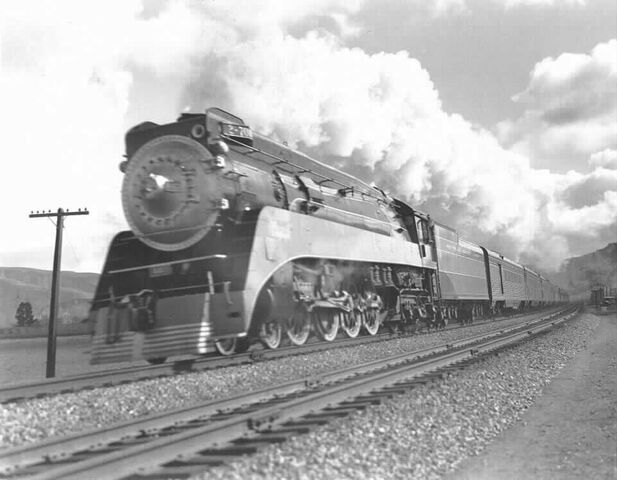
Like the above 3661, GS Northern #4412 was preserved by the SP due to how she lead the first ever train over an entirely new line. In this case, the GS-2 engine lead the Las Vegas Daylight from Las Vegas, NV to Los Angeles then San Diego when it was revealed in 1952. However, diesels quickly became the main power for said train due to the desert landscape. Nonetheless, the SP eventually sent the 4412 with some SP passenger cars to the America Rails Museum in Jersey City.
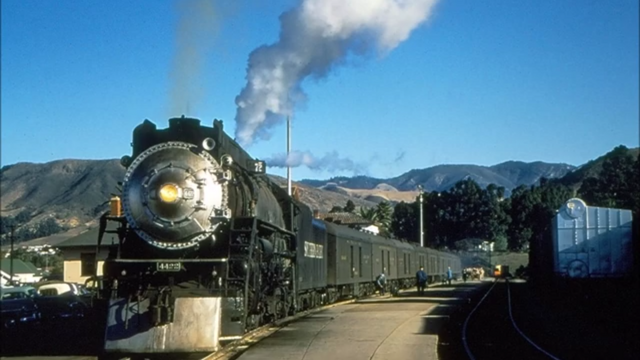
GS-3 #4422 survived to become a major display piece at the RailGiants Train Museum in Pomona. That is, once she regained her Daylight appearance.
Share: